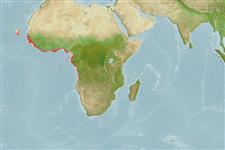>
Carangiformes (Jacks) >
Carangidae (Jacks and pompanos) > Caranginae
Etymology: Caranx: French, carangue, the name of a Caribbean fish; 1836 (Ref. 45335).
More on author: Cuvier.
Environment: milieu / climate zone / depth range / distribution range
Ecologia
marino; salmastro benthopelagico; distribuzione batimetrica ? - 200 m (Ref. 26999), usually ? - 100 m (Ref. 26999). Tropical; 25°N - 20°S
Eastern Atlantic: west coast of Africa, from Mauritania to Southern Angola (Ref. 57392).
Length at first maturity / Size / Peso / Age
Maturity: Lm 21.0 range ? - ? cm
Max length : 100.0 cm TL maschio/sesso non determinato; (Ref. 26999); common length : 50.0 cm TL maschio/sesso non determinato; (Ref. 26999)
Spine dorsali (totale): 9; Raggi dorsali molli (totale): 20-21; Spine anali 3; Raggi anali molli: 17 - 18. Diagnosis: body elongate (depth comprised 2.4-3.2 times in fork length); head ogival; snout slightly pointed; end of upper jaw extending to below centre of eye; 2 dorsal fins, 1st with 8 spines, 2nd with 1 spine and 20-21 soft rays; anal fin with 2 spines, followed by 1 spine and 17-18 soft rays; anterior lobes of dorsal and anal fins strongly developed, falciform, longer than head; pectoral fins falcate, longer than head; scales small and cycloid (Ref. 57392). Chest entirely scaleless (Ref. 57392, 81654). Posterior (straight) part of lateral line with 40-45 scutes; bilateral caudal keels present (Ref. 57392).
Coloration: back bluish-grey, sides and belly silvery-white to yellowish; in adults, vertical fins grey, other fins colourless; in juveniles, anal and caudal fins yellowish (Ref. 57392).
Inhabits coastal waters (Ref. 2683). Pelagic species that may enter estuaries and lagoons (Ref. 57391). Feeds on fish, crabs and shrimps (Ref. 28587). Maximum total length reported as 500mm in Ref. 57392.
Life cycle and mating behavior
Maturità | Riproduzione | Deposizione | Uova | Fecundity | Larve
Smith-Vaniz, W.F. and F.H. Berry, 1981. Carangidae. In W. Fischer, G. Bianchi and W.B. Scott (eds.) FAO species identification sheets for fishery purposes. Eastern Central Atlantic (fishing areas 34, 47 (in part) . Vol. 1. (Ref. 3195)
IUCN Red List Status (Ref. 130435)
Threat to humans
Harmless
Human uses
Pesca: scarso interesse commerciale
Informazioni ulteriori
BibliografiaAcquacolturaProfilo di acquacolturaVarietàGeneticaElectrophoresesEreditarietàMalattieElaborazioneNutrientsMass conversion
Strumenti
Special reports
Download XML
Fonti Internet
Estimates based on models
Preferred temperature (Ref.
123201): 16.1 - 25.8, mean 19.7 °C (based on 66 cells).
Phylogenetic diversity index (Ref.
82804): PD
50 = 0.5000 [Uniqueness, from 0.5 = low to 2.0 = high].
Bayesian length-weight: a=0.01738 (0.00796 - 0.03794), b=2.94 (2.77 - 3.11), in cm total length, based on LWR estimates for this Genus-body shape (Ref.
93245).
Trophic level (Ref.
69278): 3.9 ±0.67 se; based on food items.
Generation time: 2.4 ( na - na) years. Estimated as median ln(3)/K based on 1
growth studies.
Resilienza (Ref.
120179): Alto, tempo minimo di raddoppiamento della popolazione meno di 15 mesi (Preliminary K or Fecundity.).
Fishing Vulnerability (Ref.
59153): Moderate vulnerability (35 of 100).
Nutrients (Ref.
124155): Calcium = 32 [15, 94] mg/100g; Iron = 0.443 [0.227, 0.908] mg/100g; Protein = 18.8 [16.4, 21.3] %; Omega3 = 0.214 [0.103, 0.454] g/100g; Selenium = 97.6 [42.2, 213.5] μg/100g; VitaminA = 17 [5, 44] μg/100g; Zinc = 0.62 [0.40, 0.98] mg/100g (wet weight);
